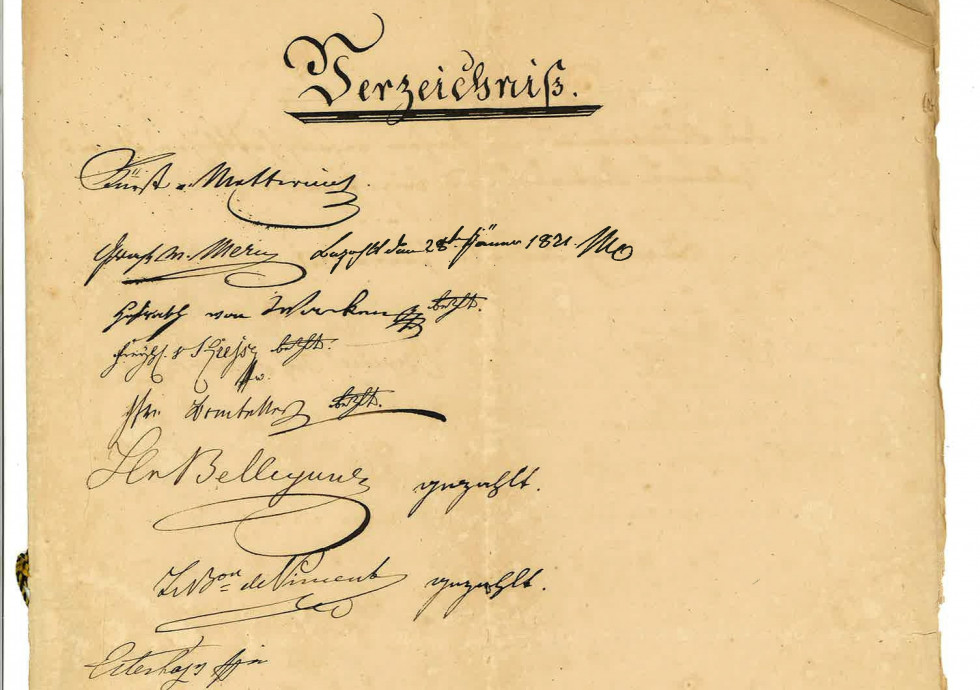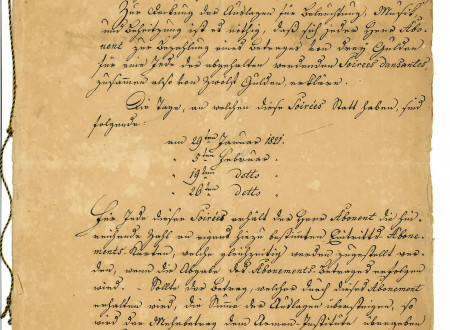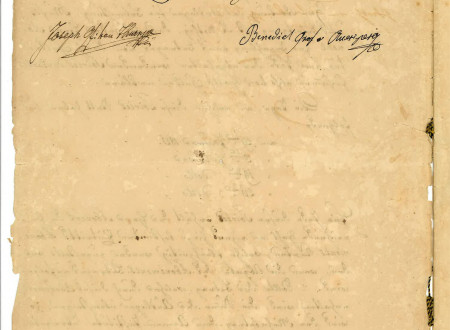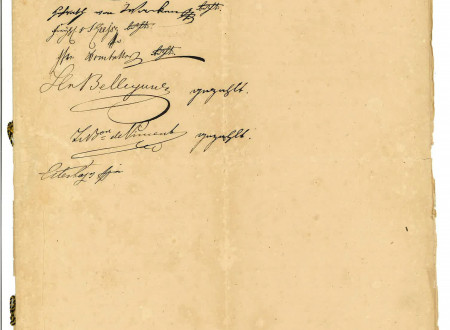Social Events During the Congress of Laibach
Invitation to Four Pre-Carnival Balls Held at the Ljubljana Dance Hall
This year marks the 200th anniversary of the Congress of the Holy Alliance, probably the most important diplomatic event Ljubljana has ever had the pleasure to host. Holly Alliance was a coalition created in 1815 between Austria, Russia and Prussia with the intention to keep the peace and retain the new European order, settled at the Congress of Vienna after the turbulent period of the Napoleonic Wars. Later, France and the majority of other European countries, apart from Great Britain and Papal States, joined the Alliance as well. Members of the Alliance agreed to meet at regular intervals and every time the maintenance of peace was in danger.
The third of the four congresses of the Holy Alliance was held between January and May 1821 in Ljubljana. It was attended by the Austrian Emperor Franz I, the Russian Tsar Alexander, the Neapolitan King of the Two Sicilies Ferdinand and a number of high ranking state representatives and diplomats, among them also Prince Klemens Wenzel Metternich, the central figure and driving force of the congress.
The Alliance first met in Troppau at the end of 1820 to discuss Spanish demands for the restoration of the constitution and similar demands from Naples. The congress was then moved to Ljubljana, which was chosen as the place of meeting partly also because of its milder climate, vicinity of Italy and sufficient facilities to accommodate so many of the distinguished guests.
While in Troppau members of the Alliance only talked of principles, in Ljubljana a decision was made to use force in Naples. Although the congress ended on February 26, the participants decided to stay in Ljubljana until the end of the intervention. The intervention itself was quick and efficient, the revolution was crushed, but things were in turmoil also in Piedmont, were revolutionaries demanded not only a constitution but also unification of Italy. The Alliance managed to supress this revolution as well and in April 1820 the old order was re-established in Piedmont.
The Ljubljana Congress also had to address the ongoing unrest in Moldavia and Wallachia directed against the Turkish dominance. Revolutionaries counted on the support of the Russian Tsar, but he chose to stand for legitimacy and Turkish authority.
Carniolan authorities and citizens of Ljubljana were not part of high politics, but were included mainly in the organizational aspect of the congress, providing accommodation, entertainment and spiritual wellbeing for their distinguished guests during their stay in Ljubljana.
This is probably the reason why there are so few archival documents on the congress, despite the significance of the event, preserved at the Archives of the Republic of Slovenia. The majority of documents is kept among the records of the archival fonds SI AS 1080, Collection of the Carniolan Museum Society, Slovene Museum Society and Carniolan History Society and refer mostly to arrival, accommodation and escort of the attendees, as well as organization of evening ballroom dances; similar records can also be found in the archival fonds SI AS 16 Provincial Presidency for Carniola. The main source of information on the event in Ljubljana, however, is a diary kept throughout the congress by Henrik Costa (fonds SI AS 845). In addition to this, we also keep some dairy entries of Franc Ksaver Richer (fonds SI AS 992), but not many. The bulk of records on the congress is kept by the Austrian State Archives in Vienna at its Haus-, Hof- und Staatsarchiv among the documents of the state office, later the ministry of foreign affairs. The minutes of all four congresses of the Holy Alliance were prepared for publication by the Institut für Neuzeit- und Zeitgeschichtsforschung and are now available online.
The congress was an opportunity for Ljubljana to experience a lively social scene that had never before been witnessed by its citizens. There were a number of military parades, musical and theatre events as well as dances. Distinguished guests received visitors, held dinners and participated in church celebrations. They took short trips to various destinations around Ljubljana and watched military parades. At the time of the congress, Emperor Franz I celebrated his birthday, which was a particularly solemn occasion.
Presented here as this month’s archivalia is an invitation to four pre-carnival balls, held at the dance hall in what is today Levstik Square. Dance hall was arranged there in 1786 by the Carniolan estates at their own expense. It was famous for its dance events which could host as many as 300 participants. Especially popular were dance evenings organized during pre-carnival time. And so in January 1821, invitations were sent out to purchase entrance ticket for four such dance evenings, the so-called soirées dancantes. Invitations were signed by Count Joseph Thurn and Count Benedict Auersperg and were sent also to distinguished attendees of the congress. To cover the costs of lighting and heating, as well as music and arrangement of the ballroom, they each had to pay three Gulden per evening, so in total twelve Gulden for all four dances. The surplus of the collected money was donated to the city poor.
The royals, naturally, did not attend such balls, but some other high ranking representatives did. The invitation exhibited here is addressed to the Austrian Imperial and Royal Secret Court and State Office and includes signatures of some of the most prominent participants of the congress, such as the state chancellor, at the time still foreign minister Count Klemens Metternich, senior officials at the foreign ministry Count Andreas Mercy and Knight Nicolaus Wacken, Colonel Count Karel Kress, Austrian ambassador at the court of Saxony Count Henrich Bombelles, the president of the court military council Count Heinrich Bellegarde, and the ambassador at the French court Baron Karl Vincent. One of the four balls took place on February 25 and was described in his diary by Henrik Costa. He reported that 650 tickets were sent out and that the ball was attended, apart from the royals, by all other distinguished guests, including ministers, ambassadors, and members of diplomatic corps, including Count Metternich. Dance hall was as bright as if it was daytime. For this particular occasion, the number of musicians was doubled and service was flawless. The atmosphere was relaxed and even Metternich danced the polonaise. The ball also found its way into literary posterity, as Ivan Tavčar dedicated several pages to it in his novel Izza kongesa.
Andreja Klasinc Škofljanec





